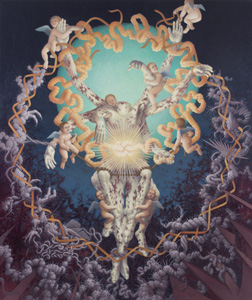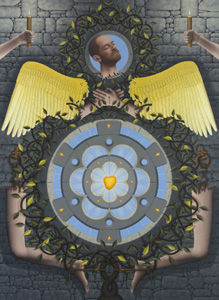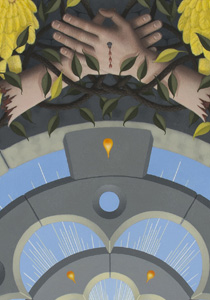
 |
| Bloodletting 1991/2013, graphite on paper sheet: 12 1/8 x 9 in. |
Bloodletting |
While doing abstraction between 1970 and 1987 my two dimensional creative process consisted of working directly on canvas or paper. Images were formed dynamically by adding, editing, and altering elements within the work itself. As such I generally did not do preliminary sketches or studies for them. In 1987 however, when I first introduced the human figure, I began doing studies as a way to work out details beforehand. Then, as my work continued to move more toward representation, the sketches and studies became more numerous, even to the point of doing full compositions and finished drawings before executing the final pieces. Over time I have accumulated stacks of these sketches and studies. Some of them have had fruitful results that led to finished drawings and/or paintings while others, for one reason or another, have not. Periodically I go through the stacks to see if any of the sketches or studies could be more fully refined or even possibly inspire new work. |
 1991-1992, acrylic on canvas, 72 x 66 in. |
 |
In 1991 I did a study for a hand I wanted to paint in Ascension. The study worked well helping me paint the hand with greater confidence. Years later in 2013, while going through a stack of sketches, I rediscovered it. As I reviewed the piece I concluded it was a nice, simple and interesting study although a bit academic. That said it intrigued me enough to decide to touch it up. As I did I became conscious of the abundant space below the hand and thought that maybe I could add something to both fill the space while also counteracting the academic feel of the piece. |
 2013-2014, acrylic on canvas, 66 x 48 in. |
 |
|
While I was revisiting the study I was also working on the painting Requiem, 2013-2014. In that painting there are two sections in which I include stylized drops of blood. It was those images that fueled the thought of introducing blood drops from the fingertips of the hand in the study. It was remarkably fortuitous in that the drops elevated the piece from a simple academic study to a visceral and intriguing work that could stand on its own. In addition I think the blood drops also linked the piece to my continuing exploration of the ideas of change and transformation. It was then that I titled the former study Bloodletting. - Brian Mains, August 2018 |